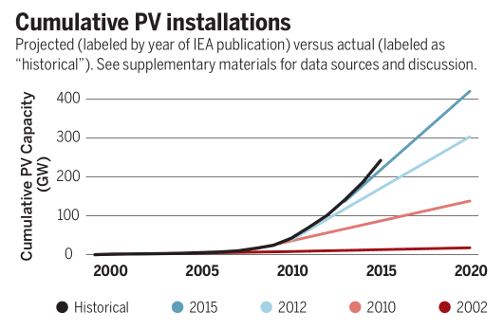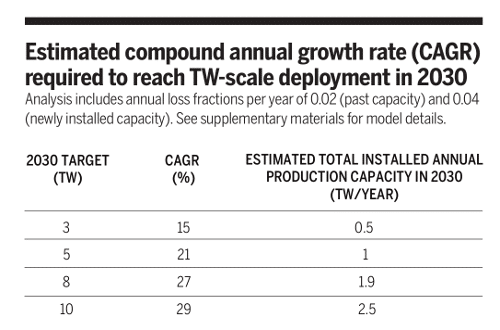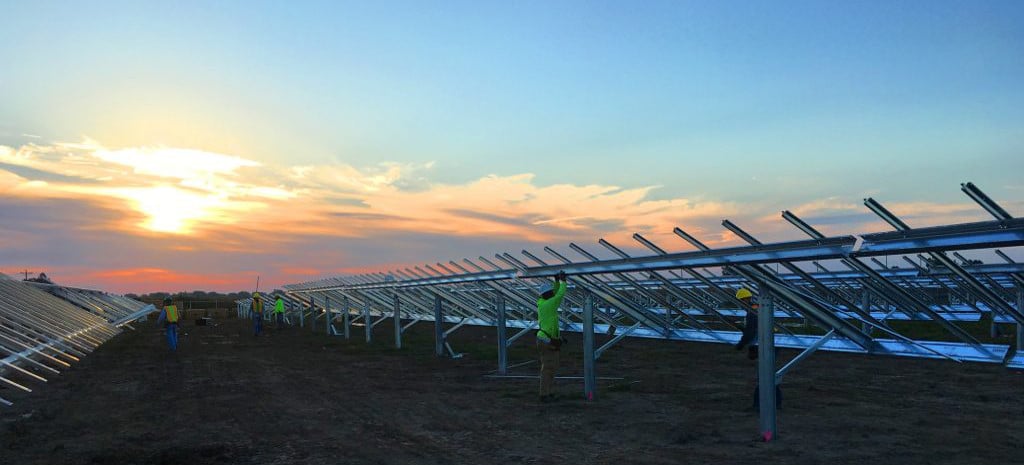It would be hard to come up with more of an all-star cast of solar researchers than the authors of Terawatt-Scale Photovoltaics: Trajectories and Challenges, a paper published earlier this week in the journal Science.
Among the 21 authors is Professor Martin Green, the father of the modern crystalline silicon solar cell, Dr. Eicke Weber, who directed Fraunhofer ISE for 10 years, and Raffi Garabedian, chief technology officer at First Solar. Not to mention Dr. Sarah Kurtz of the U.S. Department of Energy’s National Renewable Energy Laboratories (NREL) and RTS Corporation’s Izumi Kaizuka.
In the paper, this all-star team from NREL, Japan’s National Institute for Advanced Industrial Science and Technology (AIST) and Fraunhofer ISE present rough sketches of the trajectory to increase the quantity of deployed solar between 10-fold and 50-fold over the next fifteen years, as well as the technical issues such a task would face.
The good news is that PV is already on its way to a more than 10-fold increase to 3 TW of installed capacity by this date. The increase the authors discuss would only require a 15% annual growth rate, which the authors note is “substantially below what the industry has achieved over the past decade.”

Of course, you wouldn’t know this from reading the forecasts of the International Energy Agency (IEA). The assembled solar researchers note that PV growth rates have outstripped even IEA’s most optimistic projections, and that IEA is not alone in providing inadequate projections. “This tendency has been a general characteristic of many PV growth predictions,” notes the paper.
The report is clear that despite falling prices, policy support is still driving markets, including incentives and “regionally tailored project-financing structures” to address potentially high up-front costs.
Getting to $0.03/kWh
However, more ink is devoted to the twin costs of reducing costs and improving efficiencies. The researchers focus on a target to lower the installed cost of solar PV to $0.03 per kilowatt-hour (kWh), by both bringing down hardware and non-hardware “soft” costs while increasing module efficiencies to 25%.
This would involve bringing the average module price to $0.30 per watt, which the researchers note is achievable, particularly given First Solar’s roadmap to reach $0.25 per watt by 2020. However, they note a larger challenge in attempting to reduce costs and increase efficiencies simultaneously.
There is a lack of clarity as to whether the experts are talking about rooftop or utility-scale solar, as multiple nations including Mexico and the United Arab Emirates have already signed utility-scale power contracts below $0.03/kWh.
The researchers note that a challenge in this regard is that current low prices for PV modules are creating their own set of issues for technology development. “The current low prices in the marketplace make it challenging to attract investment for development, scale-up and market entry,” reads the paper.
Grid integration and storage
A thornier problem is the grid integration of high levels of renewables. While IEA has stated that today’s technologies can enable 25% to 40% wind and solar on grids with little overall system costs, this assumes that grid operators and other actors will optimize the system and does not account for political resistance.
A good example is California, which got 13% of its electricity from solar in 2016. And while California’s grid operator is predicting a big increase in solar curtailment this spring, it also continues to import power even during periods of systemwide curtailment, suggesting political decisions have been made that are interfering with the full integration of wind and solar.
The researchers sketch some of the strategies that will enable high levels of renewable energy on the grid, such as the multiple terawatts of solar envisioned. They note that while wind and solar can supply “synthetic inertia” to replace the role of large synchronous generators: “At high levels of (variable renewable energy) penetration, storage technologies will be required to bridge the gap between generation and demand.”
The report finds that like PV costs continue to fall for battery storage and notes that costs of around $150 per each kWh of rating could be low enough to enable substantial market growth. However, like other reports, the researchers note that market design is a big issue. “New market structures that monetize the value of storage will need to be considered to realize the full potential,” state the researchers.
 Electric vehicles could be an even bigger aid. “Terawatts of storage capacity could thus be available by EVs alone,” notes the paper.
Electric vehicles could be an even bigger aid. “Terawatts of storage capacity could thus be available by EVs alone,” notes the paper.
All of this and more will be essential for reaching 3 TW of installed solar, but the researchers do not stop there. The report also outlines growth rates for solar installations to reach 5, 8 and 10 TW of capacity by 2030, which would mean that solar would be the largest share of the world’s electricity production.
“Almost 200 years after Becquerel’s discovery of the PV conversion of light to electricity, the realization of this vision is both more urgent than ever and within our grasp,” concludes the paper.
This content is protected by copyright and may not be reused. If you want to cooperate with us and would like to reuse some of our content, please contact: editors@pv-magazine.com.









By submitting this form you agree to pv magazine using your data for the purposes of publishing your comment.
Your personal data will only be disclosed or otherwise transmitted to third parties for the purposes of spam filtering or if this is necessary for technical maintenance of the website. Any other transfer to third parties will not take place unless this is justified on the basis of applicable data protection regulations or if pv magazine is legally obliged to do so.
You may revoke this consent at any time with effect for the future, in which case your personal data will be deleted immediately. Otherwise, your data will be deleted if pv magazine has processed your request or the purpose of data storage is fulfilled.
Further information on data privacy can be found in our Data Protection Policy.